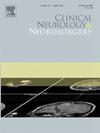动脉瘤性蛛网膜下腔出血后,血浆纤维蛋白-5的独立升高会导致慢性脑积水。
IF 1.8
4区 医学
Q3 CLINICAL NEUROLOGY
引用次数: 0
摘要
背景:动脉瘤性蛛网膜下腔出血(aSAH)会导致慢性脑积水(CH),原因是蛛网膜下腔纤维化后,脑脊液通过炎症反应或凝血产物重吸收发生障碍。纤维蛋白-5(FBLN5)是与纤维化过程相关的母细胞蛋白之一:本研究旨在评估 FBLN5 升高是否与急性脑梗死后的 CH 有关:本研究前瞻性地纳入了2013年至2016年期间日本9家医疗机构连续收治的aSAH患者。测量了第1-3、4-6、7-9和10-12天的血浆FBLN5水平。分析了血浆FBLN5水平与CH发病率之间的关系。对单变量分析中P值小于0.05的临床变量和接收者操作特征曲线(ROC)下面积最大的血浆FBLN5水平进行多变量逻辑回归分析:共分析了229例aSAH患者,其中67例发生了CH。导致随后发生CH的患者在aSAH发病后第4-6天的FBLN5水平升高。ROC 曲线分析显示,在四个时间点中,急性SAH 后第 4-6 天的曲线下面积(AUC)最高(AUC,0.592;95 % 置信区间,0.514-0.671)。使用单变量分析中与CH相关的临床变量和脑梗死后第4-6天的血浆FBLN5水平进行多变量逻辑回归分析发现,脑梗死后第4-6天的FBLN5水平≥366.4纳克/毫升(调整后的几率为3.14)是随后发生CH的独立决定因素:结论:ASAH亚急性期血浆FBLN5水平的升高可能会导致CH的发生。FBLN5可能是一种分子靶点,可用于开发针对aSAH后CH的新疗法。本文章由计算机程序翻译,如有差异,请以英文原文为准。
Independent elevation of plasma fibulin-5 proceeding chronic hydrocephalus development after aneurysmal subarachnoid hemorrhage
Background
Aneurysmal subarachnoid hemorrhage (aSAH) causes chronic hydrocephalus (CH) due to disturbance in the reabsorption of cerebrospinal fluid following subarachnoidal fibrosis via inflammatory reactions or blood clotting products. Fibulin-5 (FBLN5) is one of matricellular proteins associated with fibrosis processes.
Objective
The aim of this study was to assess whether FBLN5 elevation is related to CH after aSAH.
Methods
This study prospectively enrolled consecutive aSAH patients at 9 institutions in Japan from 2013 to 2016. Plasma FBLN5 levels at days 1–3, 4–6, 7–9, and 10–12 were measured. Relationships between plasma FBLN5 levels and incidence of CH were analyzed. Multivariate logistic regression analyses were performed on clinical variables with a p value of < 0.05 on univariate analyses and plasma FBLN5 levels with the highest area under the receiver-operating characteristic (ROC) curve.
Results
A total of 229 aSAH patients were analyzed, and CH occurred in 67 patients. FBLN5 levels at days 4–6 from aSAH onset elevated in patients resulting in subsequent CH occurrence. The ROC curve analyses revealed that the area under the curve (AUC) at days 4–6 post-aSAH was the highest (AUC, 0.592; 95 % confidence interval, 0.514–0.671) among the four time points. Multivariate logistic regression analyses using clinical variables related to CH on univariate analyses and plasma FBLN5 levels at days 4–6 post-aSAH revealed that FBLN5 levels at days 4–6 post-aSAH ≥ 366.4 ng/mL (adjusted odds ratio, 3.14) were an independent determinant of subsequent CH development.
Conclusion
The elevation of plasma FBLN5 levels in a subacute phase of aSAH may contribute to the development of CH. FBLN5 may be a molecular target to develop a new therapy against post-aSAH CH.
求助全文
通过发布文献求助,成功后即可免费获取论文全文。
去求助
来源期刊

Clinical Neurology and Neurosurgery
医学-临床神经学
CiteScore
3.70
自引率
5.30%
发文量
358
审稿时长
46 days
期刊介绍:
Clinical Neurology and Neurosurgery is devoted to publishing papers and reports on the clinical aspects of neurology and neurosurgery. It is an international forum for papers of high scientific standard that are of interest to Neurologists and Neurosurgeons world-wide.
 求助内容:
求助内容: 应助结果提醒方式:
应助结果提醒方式:


